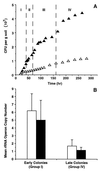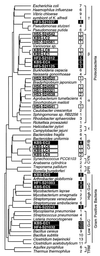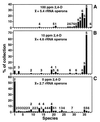rRNA operon copy number reflects ecological strategies of bacteria
- PMID: 10742207
- PMCID: PMC91988
- DOI: 10.1128/AEM.66.4.1328-1333.2000
rRNA operon copy number reflects ecological strategies of bacteria
Abstract
Although natural selection appears to favor the elimination of gene redundancy in prokaryotes, multiple copies of each rRNA-encoding gene are common on bacterial chromosomes. Despite this conspicuous deviation from single-copy genes, no phenotype has been consistently associated with rRNA gene copy number. We found that the number of rRNA genes correlates with the rate at which phylogenetically diverse bacteria respond to resource availability. Soil bacteria that formed colonies rapidly upon exposure to a nutritionally complex medium contained an average of 5.5 copies of the small subunit rRNA gene, whereas bacteria that responded slowly contained an average of 1.4 copies. In soil microcosms pulsed with the herbicide 2,4-dichlorophenoxyacetic acid (2,4-D), indigenous populations of 2,4-D-degrading bacteria with multiple rRNA genes ( = 5.4) became dominant, whereas populations with fewer rRNA genes ( = 2.7) were favored in unamended controls. These findings demonstrate phenotypic effects associated with rRNA gene copy number that are indicative of ecological strategies influencing the structure of natural microbial communities.
Figures




References
-
- Ausubel F M, Brent R, Kingston R E, Moore D D, Smith J A, Seidman J G, Struhl K, editors. Current protocols in molecular biology. New York, N.Y: John Wiley & Sons, Inc.; 1987.
-
- Bercovier H, Kafri O, Sela S. Mycobacteria possess a surprisingly small number of ribosomal RNA genes in relation to the size of their genome. Biochem Biophys Res Commun. 1986;136:1136–1141. - PubMed
-
- Bremer H. Parameters affecting the synthesis of ribosomes and RNA polymerase in bacteria. J Theor Biol. 1975;53:115–124. - PubMed
Publication types
MeSH terms
Substances
Associated data
- Actions
- Actions
- Actions
- Actions
- Actions
- Actions
- Actions
- Actions
- Actions
- Actions
- Actions
LinkOut - more resources
Full Text Sources
Other Literature Sources
Molecular Biology Databases

